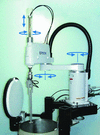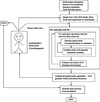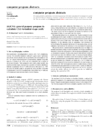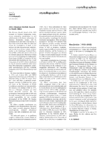issue contents
December 2002 issue

Cover illustration: The crystal structure of titanite, CaTiOSiO4, viewed down the direction of the octahedral TiO6 chains. The full green lines indicate a unit cell of the two-dimensional Ising model, used to predict diffuse scattering intensity observable in layers normal to the chain direction. Ti atoms are shown in green, Ca in light grey, O in blue. The thinner red lines are Si-O bonds, the thick red lines Ti-O1 bonds. Courtesy of T. Malcherek, C. Paulmann, M. C. Domeneghetti & U. Bismayer [J. Appl. Cryst. (2001), 34, 108-113].
research papers
A generalized approach is described for evaluating arbitrary functions of position in reciprocal space. This offers both greater convenience and often superior results for a small but ubiquitous component of almost every crystallographic computation.
A unit-cell parameter anomaly observed during the precipitation and growth of Ti3SiC2 from a Si-substituted TiC phase is interpreted as the release of latent heat. The observations are used to propose a powder diffraction method for conducting differential thermal analysis as part of in situ phase transition studies.
Download citation


Download citation


Starting from erroneous two-dimensional structures, it was possible to obtain the correct solution of the structure of a compound by the use of a combination of a systematic grid search and bond-restrained Rietveld refinement. Based on the correct molecular structure thus obtained, the crystal structures of two related compounds were routinely solved by the grid search technique.
A survey of the crystallization conditions is carried out for all known protein–protein complexes to date. Based on the survey results, a sparse screen matrix is proposed to facilitate the crystallization of protein complexes.
A polycapillary focusing optic has been tested both on a monochromatic and a polychromatic beam of neutrons. An intensity gain of as much as 5.8 ± 0.9 was observed.
Measurements on partially recrystallized samples using a monochromatic high-energy synchrotron beam show that recrystallized grains generate sharp diffraction spots, whereas the intensity from the deformed matrix varies smoothly along the Debye–Scherrer rings. Based on these observations, a method has been developed to separate the recrystallization texture components from those originating from the deformation matrix.
X-ray topographic images of micropipes in SiC arising from surface-relaxation effects are described, followed by computer simulations using the ray-tracing method.
A method is presented for determining a surface coordinate system which results in a reciprocal lattice that is simply defined in terms of the surface termination. Based on this surface coordinate system, a general formalism for the calculation of crystal truncation rod structure factors is derived, which may be easily applied to any surface that can be represented as a rational plane of a bulk crystal system.
Acceptance diagrams simplify the description of beams from focusing monochromators.
The dynamical theory of the diffractional Bragg focusing in a system of cylindrically bent crystals is developed. Two-dimensional focusing `point-to-point' is shown to be possible under certain conditions.
cryocrystallography papers
A system, implemented at SSRL, for automatically mounting and dismounting pre-frozen crystals at a synchrotron beamline is described. The system is based on a small industrial robot and compact cylindrical sample cassettes.
computer programs
The development of an approximate physical model that can be used for simulating different types of protein crystallization behavior in response to varying physico-chemical environments is presented.
A new tool for ab initio structure determination from powder diffraction is presented. It uses global-optimization algorithms and is suitable for any type of crystal structure (organic, inorganic including automatic correction of special positions), and can combine several data sets.
FULLPAT is a quantitative X-ray diffraction methodology that merges the advantages of existing full-pattern fitting methods with the traditional reference intensity ratio (RIR) method. Like the Rietveld quantitative analysis method, it uses complete diffraction patterns, including the background; however, FULLPAT can explicitly analyze all phases in a sample including partially ordered or amorphous phases such as glasses, clay minerals, or polymers.
computer program abstracts
The general-purpose program SF2CNS calculates the Fourier syntheses in the CNS format starting directly from structure factors written in various formats, without the need for any format converter or the use of CNS itself.
crystallographers
Free 

Free 



 journal menu
journal menu




































